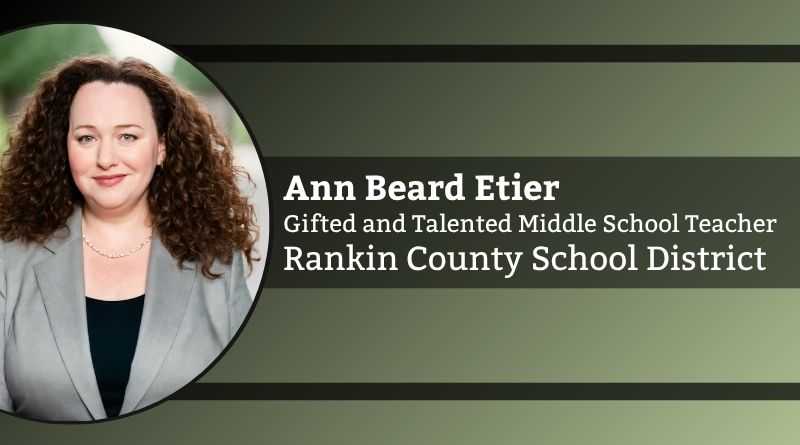Integrating Generative AI (Artificial Intelligence) in Education
By Ann Beard Etier, Gifted and Talented Middle School Teacher, Rankin County School District and Ben Beard, Librarian at Lake Forest School District
Artificial Intelligence (AI) is changing everything: how we write, think, see, create, and educate. This new wave of Generative AI represents a titanic shift in humans’ interactions with machines. Educators may disregard changes in the larger world and risk falling into obsolescence or adapting to these new technologies, enriching their teaching practice.
One of the most promising applications of Generative AI in the classroom is Generative AI, which can create content such as text, images, and even videos. Quickly generating material gets them back to directly working with learners. However, while Generative AI holds tremendous potential, its implementation raises concerns regarding student privacy, bias, inaccurate content, and teacher training. In the following sections, I outline some ways teachers can utilize Generative AI while avoiding some of the dangers and pitfalls any new technology creates.
Navigating Regulatory Frameworks: FERPA, COPPA, GDPR
AI creates a set of new worries around student rights and protections, adding layers of complexity to what is already a challenging job. There are state and federal protections already in place; it’s crucial to address existing legal frameworks such as the Family Educational Rights and Privacy Act (FERPA), the Children’s Online Privacy Protection Act (COPPA), and the General Data Protection Regulation (GDPR) in Europe. These laws and policies provide safeguards for student privacy and data protection. Any use of Generative AI in the classroom must comply with these regulations to ensure the confidentiality and security of student information. Any material we input must follow these guidelines, as should any AI platform we use.
Generative AI has the potential to revolutionize education by providing personalized learning experiences, helping with efficiency and time management, and supporting students with diverse learning needs.
Addressing Bias in Generative AI
Generative AI offers incredible outputs—video, audio, texts, and the like—with simple tools and often intuitive interfaces. The initial results are stunning. With a handful of keystrokes and some minimal inputs, students can create movies, songs, and storyboards. However, the use of these platforms to generate content is not without significant concerns around copyright, ownership, and, perhaps most worryingly, the potential for bias in the generated content.
Like all AI systems, generative models are given data to produce material. If the data used to train these models is biased, the resulting content could perpetuate stereotypes. Therefore, educators using Generative AI must be aware and vigilant and monitor all outputs for appropriateness.
There’s a second tertiary concern: Large language models, such as ChatGPT, offer results that can often contain inaccuracies, sometimes subtle, sometimes not. This is why digital literacy and the ability to critically assess information remain so crucial.
Teacher Training and Education
Teachers need adequate training and education to harness the power of Generative AI in the classroom effectively. They must know how to use the tools to demonstrate and model effective, safe, and ethical practices. Training programs should also focus on equipping teachers with the skills to evaluate and integrate AI-generated content into their lessons in ways that enhance instruction and maximize student learning outcomes. Training for teachers should include looking for bias and inaccuracies and following the privacy and safety regulations with Generative AI. It must be emphasized that educators should consider any AI-generated content as a preliminary draft, not a finished product, and review it accordingly.
It’s essential to recognize that Generative AI, like any technology, carries risks. It should be carefully monitored and supervised to ensure responsible use. Teachers and school administrators must remain vigilant in assessing AI-generated content’s quality, accuracy, and appropriateness. They should intervene when the content is biased, inaccurate, or doesn’t align with their teaching style. Active involvement in this process is crucial to prevent potential harm and misuse of AI in the classroom.
In recognizing the emphasis that must be placed on ethical and safe implementation, the benefits of Generative AI for various aspects of education must also be stressed. Generative AI can assist with research and development. It can assist students with disabilities and help with language immersion for students who speak a language other than the one taught in the classroom. It tailors lessons for students. It transforms instruction.
Time Efficiency and Instructional Support
One of the most significant advantages of using Generative AI in the classroom is its ability to save time for teachers. By creating educational materials such as worksheets, quizzes, and presentations, Generative AI frees teachers to focus on other critical aspects of instruction, such as facilitating discussions, providing feedback, and fostering student engagement. Moreover, AI-generated materials can be customized to align with specific learning objectives, enhancing the effectiveness of instruction. AI does wonders with differentiation in the classroom. Differentiated instruction is so important yet so time-consuming. Generative AI can streamline this process, giving you more time to focus on what matters- your students.
Supporting Special Needs Populations
Generative AI has the potential to revolutionize education for students with special needs. It can provide personalized learning materials tailored to individual students’ abilities and preferences, which could benefit both students and teachers. Generative AI can provide targeted support that meets diverse learning needs, helping educators better accommodate students with disabilities and learning differences. It also offers new ways for students with learning challenges to show what they know and have learned.
Maximizing Student Learning
Generative AI can maximize student learning by providing personalized, adaptive assignments and curriculum in the classroom. AI can generate content that caters to individual learning styles and paces by analyzing students’ learning preferences, performance data, and feedback. This process promotes a more profound understanding and retention of concepts. Additionally, AI-powered tutoring systems can offer real-time feedback and guidance. Students can receive personalized support whenever they need it.
Generative AI has the potential to revolutionize education by providing personalized learning experiences, helping with efficiency and time management, and supporting students with diverse learning needs. However, its implementation requires careful consideration of privacy, bias, and ethical concerns. Teacher training must be a priority. Educating teachers on AI will help safeguard student privacy and foster responsible use. This way, teachers can harness the power of Generative AI to create more inclusive, engaging, and effective learning environments for all students.

